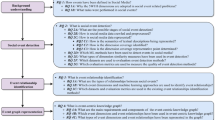Abstract
This paper addresses the mathematical relation on a set of periods and temporal indexing constructions as well as their applications. First we introduce two concepts, i.e. the temporal connection and temporal inclusion, which are equivalence relation and preorder relation respectively. Second, by studying some basic topics such as the division of “large” equivalence classes and the overlaps of preorder relational sets, we propose a temporal data index model (TDIM) with a tree-structure consisting of a root node, equivalence class nodes and linearly ordered branch nodes. Third, we study algorithms for the temporal querying and incremental updating as well as dynamical management within the framework of TDIM. Based on a proper mathematical supporting, TDIM can be applied to researching some significant practical cases such as temporal relational and temporal XML data and so on.
Similar content being viewed by others
References
Bozkaya T, Ozsoyoglu M. Indexing transaction time databases. ACM Inf Sci, 1998, 112: 85–123
Ramaswamy S. Efficient indexing for constraint and temporal databases. In: Proceedings of the 6th ICDT Conference, Delphi, Greece, ACM, 1997. 419–431
Segev A, Gunadhi H. Efficient indexing method for temporal relations. IEEE Trans Knowl Data Engin, 1993, 5(3): 496–509
Goh C H, Lu H J, Ooi B-C, et al. Indexing temporal data using existing B +-trees. Data Knowl Engin, 1996, 18: 147–165
Bozkaya T, Ozsoyoglu M. Indexing valid and time intervals. In: Proceedings of DEXA Conference, Vienna, Austria, IEEE Computer Society, 1998. 541–550
Nascimento M A. Indexing valid time databases via B+-Tree. Ph D Thesis. Southern Methodist: Southern Methodist University. 1997
Beckmann N, Kriegel H, Scheider R, et al. The R*-tree: An efficient and robust access method for points and rectangles. In: Proceedings of ACM SIGMOD, Varga, Bulgaria: ACM, 1990. 322–331
Kumar A, Tsotras V J, Faloutsos C. Designing access methods for bitemporal databases. IEEE Trans Knowl Data Engin, 1998, 10(1): 1–20
Bliujute R, Jensen C S, Saltenis S, et al. R-tree based indexing of now-relative bitemporal data. In: Proceedings of the 24th VLDB Conference. New York: ACM, 1998. 345–356
Bliujute R, Jensen C S, Saltenis S, et al. Light-weight indexing of bitemporal data. In: Proceedings of the 12th International Conference on Scientific and Statistical Database Management. Berlin: IEEE Computer Society, 2000. 125–138
Stantic B, Khanna S, Thornton J. An efficient method for indexing now-relative bitemporal data. In: Proceedings of the Fifteenth Conference of Australasian Database, Dunedin, New Zealand: ACM International Conference Proceeding Series, 2004. 113–122
Mendelzon A, Vaisman A. Indexing temporal XML documents. In: Proceedings of the 30th VLDB Conference, Toronto, Canada, ACM, 2004. 216–227
Zhang S, Dyreson C E. Adding Valid Time to XPath Lecture Notes in Computer Science, Databases in Networked Information Systems. Berlin/Heidelberg: Springer, 2002, LNCS 2544: 9–42
Wang F S, Zaniolo C. Publishing and querying the histories of archived relational databases in XML. In: Proceedings of the Fourth International Conference on Web Information Systems Engineering. California: ACM Workshop on Wireless Security, 2003. 1–10
Nørvag K. Algorithms for Temporal Query Operators in XML Databases. Chaudhri A B, eds. EDBT 2002 Workshops, Berlin/Heidelberg: Springer, 2002, LNCS 2490: 169–183
Rizzolo F, Vaisman A. Temporal XML: modeling, indexing, and query processing. The VLDB J, 2008, 17(5): 1179–1212
Ye X P, Chen K Y, Tang Y. Techenology on temporal XML index (in Chinese). Chin J Comput, 2007, 30(7): 1074–1085
Clifford J, Dyreson C, Isakowitz T, et al. On the semantics of “now” in databases. ACM Trans Database Syst, 1997, 22: 171–214
Kristian T, Christian S J, Snodgrass R T. Modification semantics in now-relative databases. ACM Inf Syst, 2004, 29(8): 653–683
Ye X P, Tang Y. Semantics on “now” and caculus on temporal relations (in Chinese). J Software, 2005, 16(05): 838–846
Snodgrass R T. The temporal query language TQuel. ACM Trans Database Syst, 1987, 12(2): 247–298
Author information
Authors and Affiliations
Corresponding author
Additional information
Supported by the National Natural Science Foundation of China (Grant Nos. 60373081, 60673135), the Natural Science Foundation of Guangdong Province (Grant No. 05003348), the Program of New Century Excellent Person Supporting of Ministery of Education of China (Grant No. NCET-04-0805)
Rights and permissions
About this article
Cite this article
Ye, X., Tang, Y., Chen, L. et al. Study and application of temporal index technology. Sci. China Ser. F-Inf. Sci. 52, 899–913 (2009). https://doi.org/10.1007/s11432-009-0115-8
Received:
Accepted:
Published:
Issue Date:
DOI: https://doi.org/10.1007/s11432-009-0115-8




